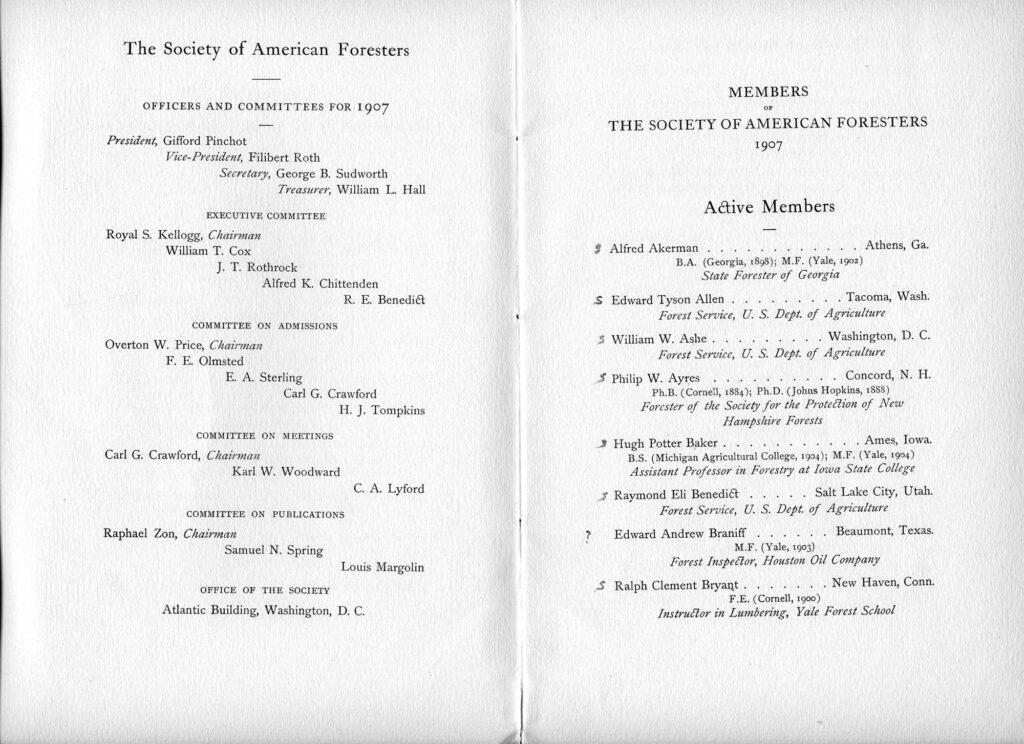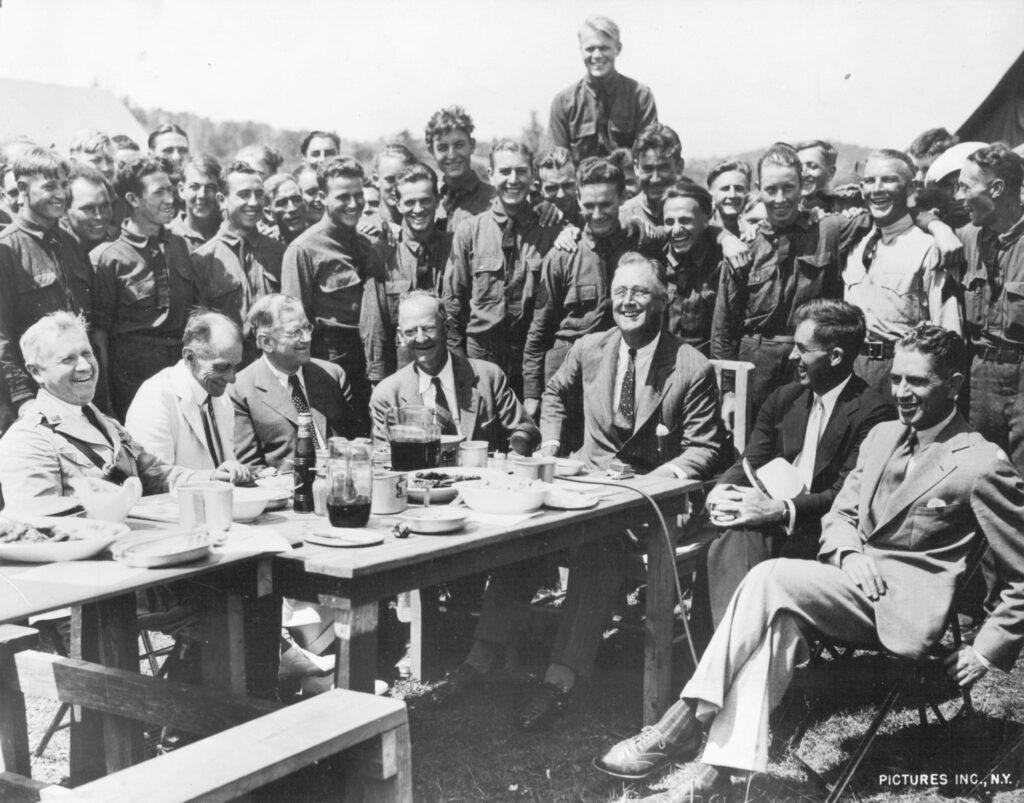November 30, 1900: Society of American Foresters Founded
On this day in history, leading conservationist Gifford Pinchot and six other foresters founded the Society of American Foresters in Washington, D.C. In its 108-year history, the Society has grown to become the largest professional organization for foresters in the world. Currently representing more than 15,000 forestry professionals and students working in private industry, educational settings, and local, state and federal government, SAF strives to advance the science and professional management of forest resources, enhance member competency, and promote sound forest management and conservation practices for the health of forest ecosystems.
The Forest History Society is the fortunate steward of the records of the Society of American Foresters -- 458.5 linear feet, with more additions anticipated! To describe SAF's beginnings, I defer to the original meeting minutes, which we hold in our collection, to provide an account:
Washington, D.C. November 30, 1900.
Minutes of the First Meeting of the Society of American Foresters.
An informal meeting of foresters was called at the office of Mr. Pinchot on the morning of November 30th. There were present Mr. [Gifford] Pinchot, Mr. [Overton] Price, Mr. [William] Hall, Mr. [Ralph] Hosmer, Mr. [Thomas] Sherrard, Mr. [E. T.] Allen, and Mr. [Henry] Graves. It was stated that the object of the meeting was to discuss the feasibility of organizing a Society of American Foresters. All those present were in favor of the organization of such a Society.
Mr. Pinchot was appointed temporary Chairman, and Mr. Graves temporary Secretary, in order that the Society might be formally organized.
A motion was made, seconded, and carried, that the society be known as the Society of American Foresters. It was then moved and seconded that a committee of three be appointed by the Chair for the purpose of making recommendations as to the complete organization of this society. The Chair appointed Mr. Graves, Chairman, Mr. Price and Mr. Hosmer. It was then decided that the Chair should call a meeting as soon as the report of the committee was ready.
Henry S. Graves, Sec'y Protem
Today also marks another significant event in forest history: the first appearance of a guest blogger on Peeling Back the Bark! To celebrate the anniversary of SAF's founding, we have invited historian Char Miller, senior fellow of the Pinchot Institute for Conservation, to comment. In his entry, Miller recalls fledgling efforts at professional forestry, debates within the field, and forestry's responsiveness to shifting challenges.
As Miller offers an overview of SAF, the rest of this post will highlight some interesting finds in our archival holdings.
The Society of American Foresters has boasted an impressive membership body; our 1907 member booklet in particular lists many influential men of the age.

Flipping through the comprehensive membership rolls, more than a few names leap out, including:
- George Patrick Ahern, then Chief of Bureau of Forestry in the War Department serving in the Philippines. Ahern also conducted extensive early explorations of modern-day Glacier Park country;
- the illustrious Carl A. Schenck of the Biltmore School and his sponsor, George Vanderbilt;
- Charles Sprague Sargent, long-time director of the Arnold Arboretum and a fellow of the American Academy of Arts and Sciences. Among other achievements, Sargent chaired the committee to investigate inauguration of U. S. forest policy (1896-1897) and authored the first authoritative national survey of forest conditions (1880);
- Herman Haupt Chapman, who was a renowned professor at the Yale School of Forestry, prolific author of textbooks and periodical articles related to forestry, and active leader in professional societies;
- three United States presidents: Grover Cleveland, Benjamin Harrison, and Theodore Roosevelt;
- and a slew of forestry professors and U. S. Forest Service operatives.
One choice piece of correspondence holds the original signature of another man who would be United States president, Franklin Delano Roosevelt.

Writing on December 5, 1931, Roosevelt, then Governor of New York, reconstructed comments he apparently made at a Forestry meeting at Hyde Park. In the closing, Roosevelt accepted membership in the Society of American Foresters.
While Theodore is the Roosevelt more commonly associated with forestry and Gifford Pinchot, Franklin also had involvement with forest management and foresters. For instance:
- FDR turned his home at Hyde Park into a showcase of reforestation, planting more than a half-million trees on 556 acres over a thirty-three-year period. He listed his occupation, even while president, as "tree grower."
- Roosevelt planted trees on his property for economic and ecological reasons. He hoped to revive the soil and return the land to farming. He turned a profit selling fuel wood, saw logs, and Christmas trees locally.
- In 1935, for these and other efforts, SAF awarded FDR with the first Sir William Schlich Memorial Award, presented for influence in forestry.
FDR maintained connections with forestry leaders as well. For example, the emergency work camps Gifford Pinchot formed as Governor of Pennsylvania provided a model for President Franklin Roosevelt's Civilian Conservation Corps.

President Franklin D. Roosevelt visits the first CCC camp, located on the George Washington National Forest, in August 1933.
The Civilian Conservation Corps, surrounding controversies, and the reorganization of federal conservation agencies during the 1930s figure prominently in our Society of American Foresters collection. Additionally, the records include correspondence and reference files concerning Society administration, elections, and membership; Society committees, especially the Committee on Natural Areas; internal controversies; publication of the Journal of Forestry, in print since 1902; timber and forestry conferences; forestry education; accreditation of forestry schools; surveys of industrial forestry; survey of state forestry administration; employment in the forestry profession; ethics; recreation; state parks; wildlife; and the U. S. Forest Service. Key individuals represented include Herman Haupt Chapman, Raphael Zon, Christopher Mabley Granger, and various Society officials. The collection also contains the papers of Samuel T. Dana, dealing chiefly with forestry education.
With correspondence, articles, unpublished surveys and studies, committee reports, and internal files touching on important natural resource and political questions throughout the twentieth century, the extensive records of the Society of American Foresters represent a veritable cornucopia of research materials.

